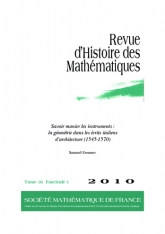Savoir manier les instruments : la géométrie dans les écrits italiens d'architecture (1545-1570)
Knowing how to handle instruments : geometry in Italian writings on architecture (1545–1570)

- Consulter un extrait
- Année : 2010
- Fascicule : 1
- Tome : 16
- Format : Électronique
- Langue de l'ouvrage :
Français - Class. Math. : 01A40, 51-03, 00A06, 51M04, 51M15, 65S05
- Pages : 1-62
- DOI : 10.24033/rhm.150
Cet article est consacré à la géométrie véhiculée par les écrits d'architecture, en particulier les écrits italiens de la seconde moité du xvie siècle. Il explore le rôle central attribué aux instruments dans cette géométrie. De quelle façon s'insère-t-elle dans les multiples traditions mathématiques de la même époque ? Elle se nourrit de fait à la fois d'apports de la tradition savante, de celle des abacistes et de la géométrie pratique. On s'attachera à mettre en évidence, dans les propositions concernant les constructions géométriques, l'alliage entre la structure d'exposition empruntée au mode « euclidien » et les instructions concernant la manipulation d'instruments. Les écrits considérés tendent aussi à élargir, au-delà de la règle et du compas, l'arsenal des instruments utilisés pour les opérations géométriques. Cette tendance apparaît comme un trait commun aux œuvres de Pietro Cataneo, Sebastiano Serlio, Giuseppe Salviati et Daniele Barbaro, alors qu'elles sont de formes et statuts très divers. Elles partagent avec les géométries pratiques de l'époque une conception sous-jacente : celle d'une géométrie entendue comme science qui concerne le maniement d'instruments mathématiques. Néanmoins, les techniques d'écriture adoptées par les auteurs sont empruntées tantôt à la tradition érudite, tantôt aux mathématiques pratiques.
Géométrie pratique, instruments mathématiques, architecture

